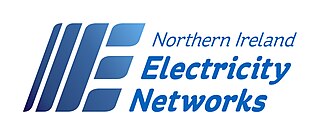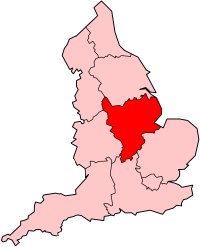SWEB Energy, formerly South Western Electricity Board (SWEB) was a British state-owned regional electricity company operating in South West England which was privatised by the Thatcher government. Although sold many times, the 'SWEB' brandname survived until 2006.
The Central Electricity Generating Board (CEGB) was responsible for electricity generation, transmission and bulk sales in England and Wales from 1958 until privatisation of the electricity industry in the 1990s.

Scottish Power is a vertically integrated energy company based in Glasgow, Scotland. It is a subsidiary of Spanish utility firm Iberdrola.

Northern Ireland Electricity Networks Limited (NIE Networks) is the electricity asset owner of the transmission and distribution infrastructure in Northern Ireland, established in 1993 when the business was privatised. NIE Networks does not generate or supply electricity. Since 2010 it has been a subsidiary of ESB Group.
The British Electricity Authority (BEA) was established as the central British electricity authority in 1948 under the nationalisation of Great Britain's electricity supply industry enacted by the Electricity Act 1947. The BEA was responsible for the generation, transmission and sale of electricity to area electricity boards, and the development and maintenance of an efficient, coordinated and economical system of electricity supply.
Norweb plc, originally the North Western Electricity Board, was a British electricity supply and distribution company. It supplied electricity to about 4.7 million industrial, commercial and domestic customers in the North West of England, although Merseyside and parts of Cheshire were instead covered by MANWEB.

National Grid plc is a British multinational electricity and gas utility company headquartered in London, England. Its principal activities are in the United Kingdom, where it owns and operates electricity and natural gas transmission networks, and in the Northeastern United States, where as well as operating transmission networks, the company produces and supplies electricity and gas, providing both to customers in New York, Massachusetts, and Rhode Island.
Public electricity suppliers (PES) were the fourteen electricity companies created in Great Britain when the electricity market in the United Kingdom was privatised following the Electricity Act 1989. The Utilities Act 2000 subsequently split these companies between distribution network operators and separate supply companies.
SWALEC was an electricity supply and distribution company in South Wales, established in 1989 following the de-regulation of the electricity supply industry in the United Kingdom. The business has seen several changes of ownership from 1996, and the SWALEC brand has been used for retail gas supply as well as electricity. Today Western Power Distribution owns the distribution network, and SWALEC is a trading name of OVO Energy.
North Eastern Electricity Board was an electricity distribution utility in England, serving the North East of England.

The Midlands Electricity Board was the public sector utility company responsible for the purchase of electricity from the electricity generator and its distribution and sale of electricity to customers in the Midlands of England prior to 1990. As Midlands Electricity plc it was listed on the London Stock Exchange and was once a constituent of the FTSE 100 Index.
E.ON UK is a British energy company and the largest supplier of energy and renewable electricity in the UK, following its acquisition of Npower. It is a subsidiary of E.ON of Germany and one of the Big Six energy suppliers. It was founded in 1989 as Powergen, and was listed on the London Stock Exchange and was once a constituent of the FTSE 100 Index. It has been a subsidiary of E.ON since 1 July 2002.
Southern Electric plc was a public limited energy company in the United Kingdom between 1990 and 1998, when it merged with Scottish Hydro-Electric plc to form Scottish and Southern Energy plc. The company had its origins in the southern England region of the British nationalised electricity industry. Created in 1948 as the Southern Electricity Board, in 1990 it was privatised by being floated on the London Stock Exchange.

Yorkshire Electricity was an electricity distribution utility in England, serving much of Yorkshire and parts of Derbyshire, Lincolnshire and Nottinghamshire.

Eastern Electricity plc was an electricity supply and distribution utility serving eastern England, including East Anglia and part of Greater London. It was renamed Eastern Group under which name it was listed on the London Stock Exchange and was a constituent of the FTSE 100 Index until it was acquired by Hanson plc in 1995, before being purchased by Texas Utilities in 1998.
SEEBOARD, formerly South Eastern Electricity Board (SEEB), was a British electricity company. The electrical power industry in the United Kingdom was nationalised by the Electricity Act 1947, when over 600 electric power companies were merged into twelve Area Boards, one of which was the South Eastern Electricity Board. It acquired the former Princes Hotel on the seafront in Hove, East Sussex, and converted it into its headquarters. The building was refurbished and substantially extended between 1979 and 1981.
The London Electricity Board was the public sector utility company responsible for the supply and distribution of electricity to domestic, commercial and industrial consumers in London prior to 1990. It also sold and made available for hire and hire-purchase domestic electrical appliances through local showrooms where electricity bills could also be paid. It was shortened to LEB in its green and blue logo, consisting of the three letters. As London Electricity plc it was listed on the London Stock Exchange and was once a constituent of the FTSE 100 Index.
SP Manweb, previously MANWEB, is the regional electricity supplier and distributor for Merseyside, North Wales and parts of Cheshire. It is now part of SP Energy Networks, itself a subsidiary of the Spanish energy company Iberdrola.

British Gas is an energy and home services provider in the United Kingdom. It is the trading name of British Gas Services Limited and British Gas New Heating Limited, both subsidiaries of Centrica. Serving around twelve million homes in the United Kingdom, British Gas is the biggest energy supplier in the country, and is considered one of the Big Six dominating the gas and electricity market in the United Kingdom.

The Electricity Act 1989 provided for the privatisation of the electricity supply industry in Great Britain, by replacing the Central Electricity Generating Board in England and Wales and by restructuring the South of Scotland Electricity Board and the North of Scotland Hydro-Electric Board. The Act also established a licensing regime and a regulator for the industry called the Office of Electricity Regulation (OFFER), which has since become the Office of Gas and Electricity Markets (OFGEM).












